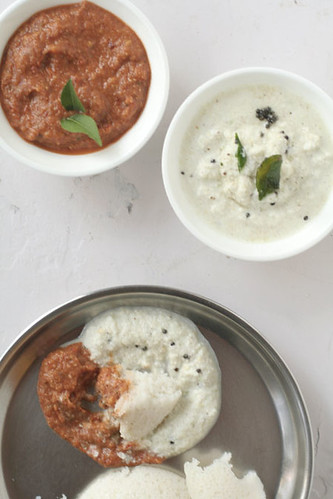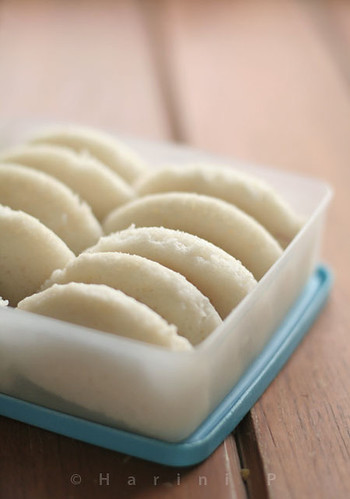Idli - Steamed rice cakes - Gluten free, guilt free
Every two weeks my son makes it a point to remind me that I haven't made idlis in a long time. A long time, being just ten to 15 days. I am not sure why people like idli so much. I myself am not too fond of it. I always loved dosas. These days however, I prefer idlis as they are steamed and do not call for a teaspoon of oil around the periphery like dosas, and I have become conscious that the teaspoons per dosa add up to quite a bit, especially when there is chutney to go with them. My son on the other hand is a thin boy and can afford to eat dosas to his heart's content without them making handles around his waist, but ironically he seems to prefer idlis. He loves to dunk the soft, fluffy pieces of idli in coconut chutney, let it take all the goodness of the coconut juice. It is quite a sight to see him enjoying a mouthful as he lets his tastebuds take over!
When I wrote the traditional Tamilian idli post for Dawn, the comment section became a ground of discussion as people wised others about types of idlis and some even tried pulling in a bit of politics into the food court. Thankfully idlis ruled and the divisions were stymied as both the countries have some ardent foodies who poured in their love for idlis. It however firmly established what I had always believed - that the way to people's heart is only food! How else does one explain the indignant man who mentioned that my ratio of 3:1 [rice:dal] was totally wrong and that his wife, a wonderful cook made the best idlis by following the ratio of 2:1! I was intrigued. I knew my method was correct. After-all it had been established by generations of Mums and Grand mums who lovingly ground 'ollocks' [old Indian system of measuring] of rice and dal in their 'aattukallus' [Manual grinding stones used in India].
My pati would have been flabbergasted at the impudence of the man who suggested a different ratio. But well, times have moved. My pati's grand-daughter [that's me], though initially distraught got back her cool [as I think my pati would have]! I decided to try the new ratio with the ardent faith of a skeptic!
Since idlis are made ever so often in the TT household the chance came by soon. I first measured 2.5 cups of puzhangal arisi [par boiled rice], rinsed it and soaked. I know, I know it was supposed to be 2 but I could not resist adding the extra half. The skeptic reigned and that is not my fault! When I reached for the ulund [split black gram lentil], I was disappointed to find that the quantity had reduced and measured only 1/2 a cup. Too lazy to go to the shop late in the night, I decided to substitute the other 1/2 cup with payatham paruppu [split mung bean lentil]. Two changes spelled only lesser faith in the ratio set by the man who commented.
Next morning the grinding ritual began and as I scraped down the remnants of the batter from the stone I wondered whether the batter would rise as much as the regular one. A teeny weeny bit of my heart wished it wouldn't. Then I could blame the commentator! To my surprise, I saw that indeed the batter rose. I placed the undisturbed batter in the refrigerator.
This morning I woke up, thawed the batter for an hour and poured ladlefuls into idli depressions, steamed them on high for five minutes and on low for ten minutes, like I usually do. While the steamer cooled I made the cooconut chutney and tomato chutney to go with the idlis. I would have settled for molagaipodi some other time but this time I made chutneys just to hide any faults the new ratio might create. My son, the taster can find out the slightest faults! The steamer cooled, the plates were laid out. They looked as good as they usually did as they cooled their heels. I took out the small shiny idli removing spoon my daughter had gifted me last year, pushed the spoon round the edges and out plopped the idlis, looking like how they are normally described. They were indeed soft, fluffy, pillowy clouds of white. The mung beans made no difference what-so-ever to the taste, sight or texture. The new ratio did not make the idlis any worse. Ok! Stop thinking I am a prude! I accept they were as good as my pati's idli!
Sadly, I have to concede that the commentator was right in writing in that his wife was a wonderful cook! But happily for me, my ratio is still as good. Besides I decided that the ratio must have been given to his wife by her pati. That made me happy and peaceful! It is not about the recipe being right or wrong. It is just a matter of preference! Idlis with 2:1 ratio taste as good as idlis with 3:1 ratio! I am assuming that the half cup extra did not make much difference. What is your ratio?
Here is the final recipe for the idlis with mung beans!
Dish: Idli again (Idli I and the Dawn Idlis can be found by clicking the respective links)
Yield: 30-35 idlis
Allergy information: Gluten free, lactose free, nut free, soy free, vegan.
Ingredients:
Par-boiled rice (Ukda chaawal) - 2.5 cups
Dehusked, black gram lentil (Urad dal) - 1/2 cup
Dehusked, green gram lentils or mung bean (Moong dal) - 1/2 cup
Fenugreek seeds (Methi dana) - 1 tsp.
Method:
Pick, clean and rinse the rice in several changes of water till water runs clear. Pour water, twice to the amount of rice and let it soak.
Pick, clean the lentils and fenugreek seeds. Rinse as before and soak the three together in sufficient amount of water (twice the quantity of lentils).
The ingredients should be soaked for at least six to eight hours till they plump up well.
After soaking, drain the liquid and grind the lentils in fresh water. Use water just enough to get a fluffy, light batter. Do not add too much water. When the batter becomes as light as whipped cream, remove from the grinder and pour into a big vessel. Should take about 20 minutes.
Drain the liquid from the rice and grind to a soft, slightly grainy consistency. This will take time, about 3o minutes. The water needed to grind rice will be lesser than that needed for lentils. Do not make a runny batter.
Pour the rice batter along with the lentils. Add salt to taste. A teaspoon of til oil and beat the batter well.
The vessel used should be about two and a half times the quantity of batter as it will rise quite high.
Cover the vessel and let the batter ferment for about seven to nine hours, depending on how sour you like your idlis.
After the fermentation you can make the idlis immediately or refrigerate for later use. It will remain good for about four or five days in Tropical conditions.
When ready to use:
Grease idli moulds or cups and pour ladlefuls of batter into them. Do not mix the batter for best results. You have done all that fermentation for the wild yeast to take over. Mixing will beat the bubbles.
Using a steamer or a cooker, steam the cups/moulds for five minutes on high heat and later ten minutes on low.
Let it cool naturally. Open and remove the cups. Let the steamed rice cakes cool for about five to ten minutes before demoulding with a sharp spoon.
Serve with coconut chutney, molagaipodi (spicy powder to go with the idlis), and tomato chutney [recipe follows].
Idli with tomato chutney
Dish: Tomato chutney or Thakkali thogayal
Yield: 1 bowl
Ingredients:
Onion - 1/2 cup, diced big
Tomatoes - 1 cup, diced big
Pigeon peas (Tuvar dal) - 1 tbsp.
Bengal gram lentils (Chana dal) - 1 tbsp.
Dried red chillies - 2
Curry leaves - 1 sprig
Salt to taste
Oil - 1 tsp.
Method:
Warm and a pan and heat oil.
Add the two lentils and roast till pink. Set aside.
Now roast the dried red chillies till dark and set aside.
Roast curry leaves till crisp but green. Set aside.
Roast the onions till brown. Remove.
Roast tomatoes with a touch of salt for about ten minutes till wilted.
Grind the above with salt to taste to a grainy consistency or smooth if you like.
Taste, adjust salt, garnish with curry leaves and serve with idli or dosa.
 Idli with chutneys
Idli with chutneysLabels: Harini P, Idli, Idli with chutney, South Indian cuisine, Sunshinemom, Tamilian Cuisine, Thakkali thogayal, Tomato chutney, Tongue ticklers
